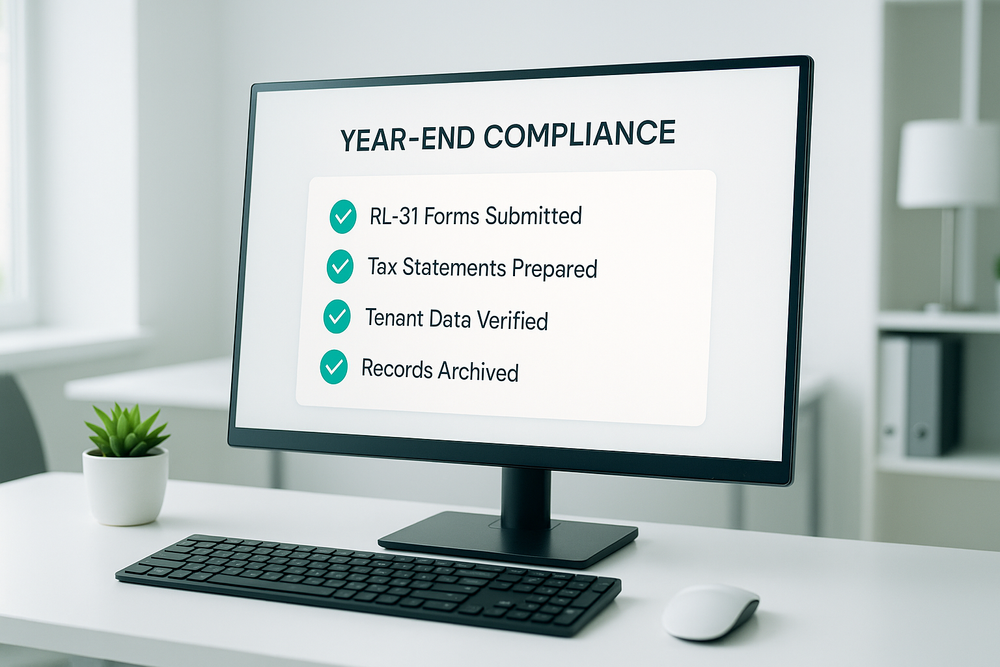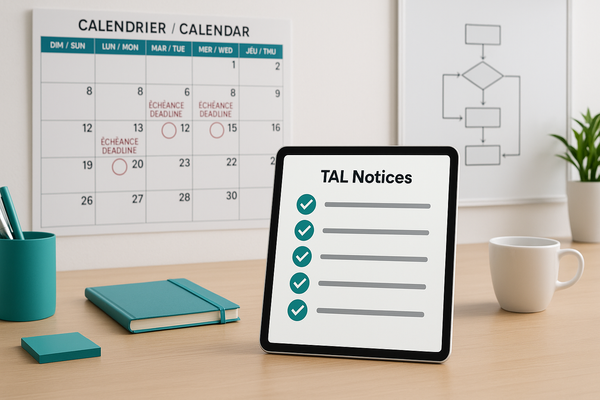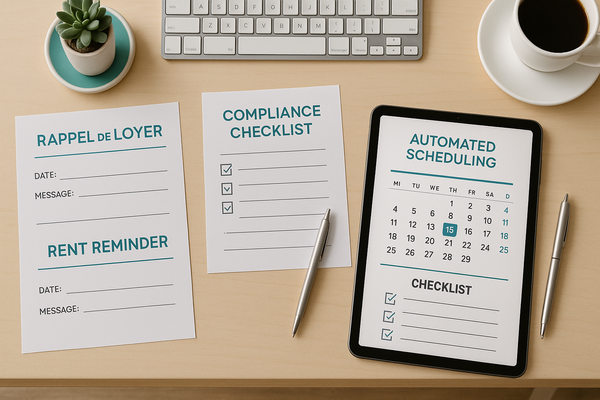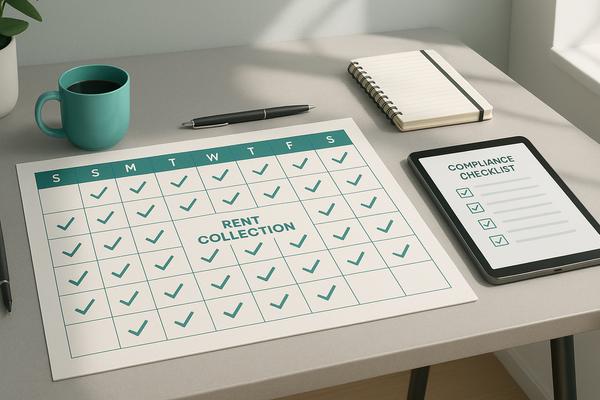RL-31 Automation: A Guide to Ending Year-End Admin Chaos
Struggling with year-end admin chaos, especially when it comes to preparing and filing Quebec’s RL-31 tax forms? If you’re managing multiple rental units, manually compiling these documents can eat up hours, cause costly errors, and put you at risk of compliance delays—all while pulling your focus from growing your business.
While RL-31 e-filing itself must be handled with certified, government-approved software, there’s a lot property managers can do to streamline the admin around the RL-31—like data prep, tracking, tenant communications, and recordkeeping—using smart automation.
This guide walks you through practical steps for simplifying your RL-31 workflow and overall year-end process. You’ll learn how to help your team save hours, avoid penalties, and scale operations with less hassle—turning tax season from a headache into a strategic advantage.
Understanding the Year-End RL-31 Filing Challenge
What Is the RL-31 Form and Who Must File It?
The RL-31 is a crucial tax slip that property managers in Québec must complete annually to report rent payments. Its primary purpose is to provide Revenue Québec with accurate information for calculating tenant tax obligations and verifying compliance with the TAL (Loi sur la taxe d’accise). Property management companies acting on behalf of landlords are legally responsible for preparing and submitting RL-31 forms for each tenant who paid rent during the year. This obligation covers all residential rental units under management, making it a fundamental compliance requirement. In fact, according to '75+ Property Management Statistics: Digital Revolution (2025)', around 60% of property managers report that compliance regulations have increased their workload, making this an industry-wide challenge.
The RL-31 also plays a pivotal role in tenant relations, as it provides tenants with the official documentation they need for their personal tax returns. Misfiling or delays not only risk fines but can also damage your reputation as a trustworthy property manager.
Common Pain Points in Manual RL-31 Preparation
Preparing RL-31 forms manually often creates a significant administrative bottleneck, especially as a portfolio grows. Collecting rent data from various sources—rental agreements, payment receipts, bank statements—is time-consuming, particularly if records are inconsistent. This process often involves sifting through multiple spreadsheets and paper files to compile accurate figures for each tenant.
Manual data entry is inherently prone to errors—such as mistyping rent amounts or mixing up tenant names—which can lead to inaccurate filings and trigger compliance issues. Missing submission deadlines exposes you to penalties and bureaucratic hassles during an already busy year-end period. This administrative overload amplifies staff stress and burnout, distracting from higher-value tasks like property maintenance and tenant relations.
How Automation Solves These Challenges
By implementing RL-31 automation tailored for Québec property managers, you can dramatically streamline this process. Custom workflows powered by tools like N8N and AI agents connect your rental management software, accounting systems, and tenant databases into a unified pipeline. This automation pulls rent data directly from your sources, verifies entries for consistency, and compiles error-free RL-31 records.
Automated systems can schedule reminders before filing deadlines and generate pre-filled, compliant RL-31 forms ready for review, minimizing manual work. The right RL-31 tax software will integrate with Revenue Québec’s e-filing portal; we advise clients on selecting and setting up the best tools for this step. The benefits are clear: you’ll cut administrative hours, improve compliance accuracy, and free your team to focus on growth and tenant satisfaction.
Key Benefits of Automating Your RL-31 Filings
Slash Year-End Admin Time and Reduce Errors
Manual preparation of RL-31 forms is one of the most time-consuming tasks during the year-end period, involving cross-referencing records across multiple platforms. This process quickly eats into your team's time, pulling focus from essential operations. This is a common challenge, as industry research on PropTech adoption drivers shows that automating repetitive tasks is a primary motivation for adopting new technology.
Implementing RL-31 automation dramatically reduces this workload by extracting rent data directly from your property management software. This aligns with recent findings highlighted in 'Survey Results Show Power of Property Management Technology', which found improved operational efficiency was the top benefit realized from PropTech adoption, cited by 63% of firms. Automatic validation checks also serve as a safeguard against common filing mistakes, alerting you to issues before submission.
Ensure Reliable Compliance and Peace of Mind
Québec’s TAL regulations impose strict requirements for RL-31 filings. Staying current with these evolving rules can be challenging if your software isn’t tailored for Québec-specific compliance.
RL-31 tax form software integrated into your workflow ensures your filings always align with the latest legal stipulations. Automated tracking of submission statuses provides a clear audit trail, so you can verify which forms have been successfully submitted and which are pending. This gives you a clear compliance overview and peace of mind. Automated solutions also archive all RL-31 submissions securely, making future reference for audits or tenant inquiries quick and straightforward.
Enhance Tenant Communication and Data Accuracy
A key benefit of automating RL-31 filings is the ability to sync tenant information directly from your property management system. When tenant data is automatically imported, you drastically reduce manual entry errors that can cause delays or penalties.
Automation also enables the generation of precise RL-31 forms tailored for tenants, with automatic population of rent paid and relevant dates. Timely and accurate delivery of tax documents fosters transparency and trust. When tenants receive their RL-31 forms electronically, they can easily verify their rent payments and claim deductions without confusion. This proactive approach, a key part of what IREM's guidance on tech for tenant engagement highlights, positions your operation as professional and compliant.
A Step-by-Step Guide to Implementing RL-31 Automation
Step 1: Assess Your Current Workflow and Technology Gaps
Start by mapping out how your team currently prepares and submits RL-31 forms. Document each step to see where delays, errors, or bottlenecks occur. Are you using multiple spreadsheets? Are records inconsistent? These gaps create compliance risks. Next, evaluate your existing tools. If your current property management software lacks robust integration for tax filing, it's time to consider specialized property management compliance automation solutions designed for Québec’s regulations.
Step 2: Choose Property Management-Focused Tax Software
Select RL-31 software tailored for Québec’s regulatory landscape. Look for solutions with Québec-specific data validation, seamless integration with popular property management platforms, and robust automation capabilities. Trusted software options often offer direct integration with electronic filing portals mandated by Revenue Québec, ensuring your forms are submitted correctly and on time. When evaluating tools, check if they can connect directly to your existing systems to pull tenant data without duplicate entry.
Step 3: Integrate and Configure Your Automation Solution
Once you've selected a tool, integrate it with your existing property management platform. This involves establishing a secure data sync that regularly pulls tenant information like rent amounts and lease dates. Our team can help you design and connect custom data pipelines between your property management tools, accounting systems, and RL-31 e-filing solutions. After integration, customize the form fields and validation rules to mirror Québec’s requirements. Finally, train your staff on the new automated process to ensure smooth adoption and confident portfolio management.
Step 4: Automate Data Collection and Form Generation
With your system set up, the automation can pull tenant payment histories and lease information directly from your database, eliminating manual entry and transcription errors. Configured workflows can then schedule batch submissions to TAL electronically, ensuring forms are filed ahead of deadlines. For example, automated triggers can compile and submit all RL-31 forms in one batch after your rent collection updates are finalized, saving hours of administrative work and preventing late filings.
Step 5: Monitor Compliance and Maintain Records Seamlessly
Automation doesn’t end with form submission. Set up your system to track deadlines, generate reminders, and confirm submissions with Revenue Québec. This continuous oversight minimizes compliance risks as regulations evolve. Maintain organized digital records of all submitted RL-31 forms and correspondence. In case of an audit or tenant inquiry, having a secure, accessible archive simplifies your response and verification processes, helping you confidently handle TAL requirements at scale.
Quick-Win Checklist for RL-31 Automation
- Validate all tenant data: Before running automation, confirm rent amounts, lease dates, and contact details are current in your system to prevent filing errors.
- Choose Québec-specific software: Select a tool designed for TAL compliance that integrates smoothly with your existing property management platform.
- Automate form generation and e-filing: Set up workflows to automatically create and submit forms through Québec’s portal to meet deadlines effortlessly.
- Train your team on the new process: Ensure everyone understands their role in monitoring the automation and reviewing outputs well before tax season.
- Set up post-submission checks: Create automated routines to confirm successful submissions and maintain a clear audit trail for compliance.
- Analyze reports for next year: Use automation data to identify and fix process gaps, making the next tax cycle even smoother.
- Communicate clearly with tenants: Use automated notifications to inform tenants when their RL-31 forms are ready, building trust and reducing support calls.
Turn Compliance into a Strategic Advantage
Free Up Management Capacity to Focus on Growth
Implementing RL-31 automation transforms your year-end process from a stressful scramble into a predictable operation. When your system automatically handles tenant data, validates entries, and submits forms, your team can redirect its energy toward strategic initiatives like expanding your portfolio or improving tenant retention. This aligns with best practices for future-proofing business operations that emphasize using tech to free site teams for resident-focused work.
Reduce Admin Burnout for Leaner, Scalable Operations
Manual RL-31 preparation often pushes staff to their limits, leading to burnout and errors. By automating these tasks, you create a leaner, more efficient workflow that minimizes repetitive labor. This shift not only reduces staff stress but also enhances operational resilience, enabling you to grow confidently. It’s a move that business leaders endorse, as research from '2025 Workflow Automation Trends' shows that 70% of business owners believe that automation facilitates scaling operations.
Enhance Tenant Trust with Flawless Document Handling
Tenants rely on accurate RL-31 forms to file their personal taxes. By adopting property management compliance automation, you ensure every tenant receives error-free, timely tax documents. This transparency builds trust and demonstrates your commitment to professional, compliant management—an essential factor in tenant satisfaction and retention. Automated, error-free delivery reduces tenant disputes related to rent reporting and reinforces your reputation as a reliable Québec property manager.
Your Path to Property Management Efficiency
Ending year-end administrative chaos isn't just about surviving tax season—it's about transforming a major compliance headache into a strategic advantage. By automating the RL-31 process, you replace manual errors and staff burnout with reliable accuracy, improved tenant trust, and enhanced operational efficiency. This shift frees up your team's valuable time, allowing you to focus less on tedious paperwork and more on what truly matters: delivering exceptional service and growing your business. The ultimate goal is to scale your portfolio, not your admin costs.
Need to make year-end smoother—without the RL-31 headaches? Let’s chat about automations that save you time on rent, maintenance, and lead management so you’re always audit-ready. Book a free consultation with WorkflowLeaf.



